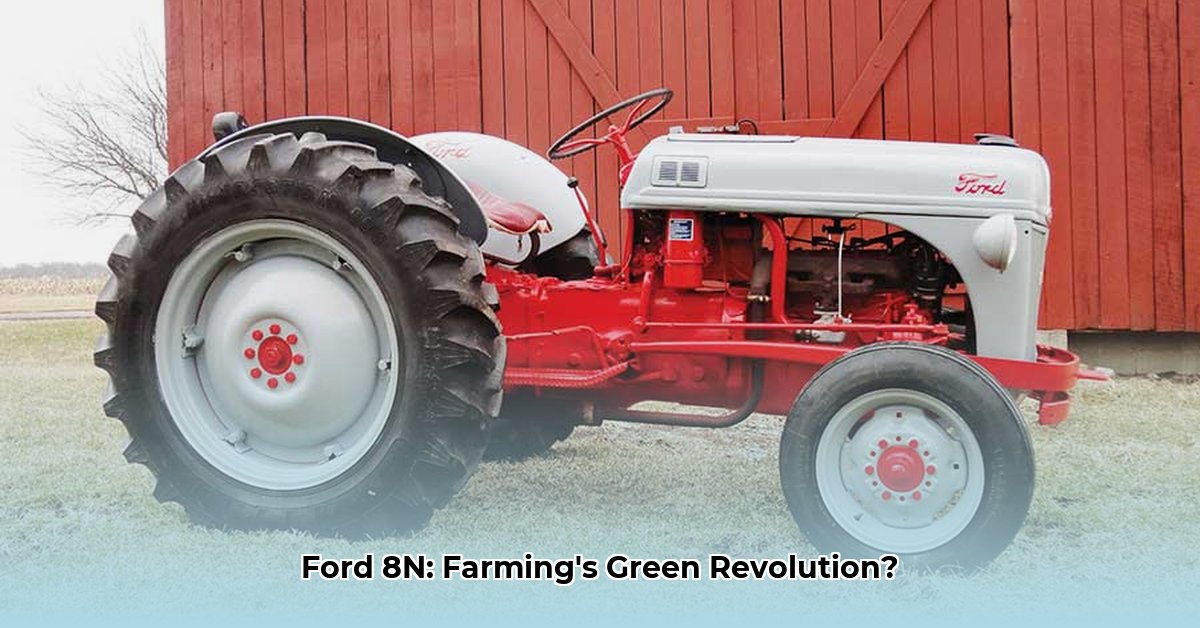
The 8N's Rise: Post-War Agricultural Transformation
The Ford 1952 8N tractor emerged in the post-World War II era, a time of burgeoning agricultural needs. Facing a growing global population, farmers sought ways to significantly increase crop yields. The 8N, with its approximately 30 horsepower, offered a compelling solution. Its relatively compact size, compared to larger industrial tractors, made it ideal for smaller farms, significantly increasing their productivity. Tasks previously requiring days could now be completed in hours, revolutionizing agricultural efficiency. Was this increase in efficiency, however, truly sustainable? For more in-depth information, see the 8N resource.
Efficiency vs. Environmental Impact: A Complex Equation
While the 8N undeniably boosted agricultural output, its environmental impact requires careful consideration. Its reliance on gasoline, a non-renewable resource, resulted in considerable greenhouse gas emissions. This raises a crucial question: Did the increased efficiency outweigh the environmental cost? The answer is multifaceted and necessitates a detailed analysis encompassing factors such as land usage and farming practices. How can we reconcile increased productivity with the environmental consequences of increased fuel consumption?
Technical Specifications and Practical Applications
The 8N's technical features offer insight into its capabilities. While its exact weight varies slightly across sources, its innovative three-point hitch system and power take-off (PTO) were groundbreaking for their time. The three-point hitch simplified the attachment of various implements, enhancing versatility. The PTO enabled the powering of external equipment, such as hay balers and grain mills. Its 12-gallon fuel tank, while modest by modern standards, was representative of the era. However, a direct comparison with modern tractors, considering work output per gallon of fuel, is crucial for a comprehensive assessment of its efficiency.
Key Technological Features:
- Three-Point Hitch: (A system enabling easy attachment of implements to the tractor)
- Power Take-Off (PTO): (Allows the tractor to power external machinery)
Sustainability: A Shifting Paradigm
Our understanding of "sustainable agriculture" has evolved considerably since the 1950s. While the 8N's simple design facilitated self-repair, extending its lifespan and reducing waste, its reliance on fossil fuels directly conflicts with modern sustainability objectives. Judging the 8N requires considering both its historical context and present-day standards, demanding a nuanced historical and environmental analysis.
The 8N's Enduring Legacy: A Balanced Assessment
The 8N's contribution to increased food production was undeniably substantial. A complete evaluation, however, necessitates a thorough comparison with both pre-mechanization farming (horse-drawn) and contemporary tractors. How does its fuel efficiency and environmental impact compare to these alternatives? What is the true cost of that efficiency increase, particularly given our current understanding of climate change? Answering these questions is critical to understanding its role in agricultural history.
Fuel Efficiency and Sustainable Practices: A Deeper Dive
The Ford 8N's fuel efficiency is highly variable, dependent on factors such as engine maintenance, operational conditions, and fuel quality. Assessing fuel efficiency for sustainable farming requires meticulous tracking and analysis.
Key Steps for Assessing Fuel Efficiency:
- Establish a Baseline: Track fuel usage over a consistent period of similar tasks, recording gallons consumed and hours of operation to calculate gallons per hour.
- Account for Operational Variations: Note how factors like terrain and load influence fuel consumption.
- Ensure Proper Engine Maintenance: Regular tune-ups significantly impact fuel efficiency.
- Utilize Recommended Fuel: Using the correct fuel grade, as specified in the owner's manual, optimizes performance and longevity.
- Analyze Data: Compare fuel consumption under different conditions to identify areas for improvement.
Analyzing the 8N's Sustainability: A Comparative Perspective
While the 8N's longevity reduces the environmental impact of manufacturing and disposal compared to frequently replacing modern tractors, its higher fuel consumption and emissions require careful consideration. Exploring alternative fuels, where feasible, may mitigate its environmental impact. Ultimately, a holistic analysis is needed, considering not only fuel efficiency but also land management practices and other environmental factors.
Conclusion: A Legacy of Innovation and Environmental Challenges
The Ford 1952 8N tractor represents a pivotal moment in agricultural history, significantly increasing productivity and shaping modern farming practices. However, its contribution to sustainable agriculture remains a complex issue, requiring a balanced assessment of its historical context and contemporary environmental standards. Further research, particularly comparing its fuel consumption and emissions to both preceding and succeeding technologies, is essential for a complete understanding of its legacy.